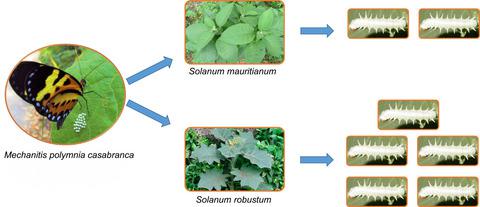当前位置:
X-MOL 学术
›
Entomol. Exp. Appl.
›
论文详情
Our official English website, www.x-mol.net, welcomes your feedback! (Note: you will need to create a separate account there.)
Host plant selection and larval performance in the Neotropical butterfly Mechanitis polymnia casabranca
Entomologia Experimentalis et Applicata ( IF 1.9 ) Pub Date : 2021-01-10 , DOI: 10.1111/eea.13011 Márcio Romero Marques Carvalho 1 , João Vasconcellos‐Neto 1
Entomologia Experimentalis et Applicata ( IF 1.9 ) Pub Date : 2021-01-10 , DOI: 10.1111/eea.13011 Márcio Romero Marques Carvalho 1 , João Vasconcellos‐Neto 1
Affiliation

|
The preference–performance hypothesis states that female insects oviposit on plants that result in optimal larval development. The objective of the present study was to evaluate the use of host plants of the genus Solanum by female butterflies of Mechanitis polymnia casabranca Haensch (Lepidoptera: Nymphalidae) and the performance of larvae reared on different species of Solanum. We performed field observations and oviposition experiments to evaluate the use of host plants. In the field, we recorded the abundance of host plants of the species Solanum robustum H. Wendl, Solanum mauritianum Scop., Solanum scuticum M. Nee, and Solanum paniculatum L. with and without oviposition by M. polymnia. In the oviposition experiment, we grew host plants representing common species in the field (S. mauritianum, S. robustum, and S. scuticum) in pots, with one plant per pot, which were then grouped in blocks of three plants, one of each species (n = 10 blocks). In the larval performance experiment, we reared larvae on leaves of one of three Solanum species and maintained them under controlled temperature and photoperiod conditions. We recorded the survival, larval development time, adult wing size, dry weight, and larval digestibility indices. In the field, females oviposited more frequently on S. robustum despite the greater abundance of S. mauritianum. In general, larvae reared on S. robustum or S. scuticum had highest larval performance. Larval mortality was higher in larvae reared on S. mauritianum (40.9%), followed by larvae reared on S. scuticum (7.5%) and S. robustum (6.8%). The adult wing size and dry weight were the highest in males and females originating from larvae reared on S. robustum. The results suggested a positive relationship between oviposition preference and larval performance in M. polymnia casabranca.
中文翻译:

新热带蝴蝶多发性机制性多面体casabranca的寄主植物选择和幼虫性能
偏好表现假设指出,雌性昆虫在植物上产卵,从而导致幼虫的最佳发育。本研究的目的是评估多虫性机械病(Mechanitis polymnia casabranca Haensch)(鳞翅目:Nymphalidae)的雌性蝴蝶对茄属植物寄主植物的利用,以及在不同茄属植物上饲养的幼虫的性能。我们进行了现场观察和产卵实验,以评估宿主植物的使用。在田间,我们记录了坚固的茄属植物H. Wendl,茄属茄属,Scutumum M. Nee和茄属植物的寄主植物的丰度。L.有和没有产卵症的M. polymnia。在产卵的实验中,我们长大表示本领域公物种(寄主植物S. mauritianum,S.粗壮,和S. scuticum在盆),以每盆一株,然后将其在三个植物,中的一个的块分组每个物种(n = 10个区块)。在幼虫性能实验中,我们将幼虫饲养在三种茄科植物之一的叶片上,并使其保持在受控的温度和光周期条件下。我们记录了存活率,幼体发育时间,成年机翼大小,干重和幼体消化率指数。在田间,强壮链球菌的女性产卵频率更高尽管毛里求斯葡萄的数量较多。通常,在强壮链球菌或S. scuticum上饲养的幼虫具有最高的幼虫性能。幼虫死亡率在幼虫饲养较高S. mauritianum(40.9%),其次是幼虫饲养S. scuticum(7.5%)和S.粗壮(6.8%)。成年翅的大小和干重在雄性和雌性中最高,它们来自于鲁棒链球菌饲养的幼虫。结果表明,产卵喜好与M. polymnia casabranca的幼虫性能呈正相关。
更新日期:2021-02-15
中文翻译:

新热带蝴蝶多发性机制性多面体casabranca的寄主植物选择和幼虫性能
偏好表现假设指出,雌性昆虫在植物上产卵,从而导致幼虫的最佳发育。本研究的目的是评估多虫性机械病(Mechanitis polymnia casabranca Haensch)(鳞翅目:Nymphalidae)的雌性蝴蝶对茄属植物寄主植物的利用,以及在不同茄属植物上饲养的幼虫的性能。我们进行了现场观察和产卵实验,以评估宿主植物的使用。在田间,我们记录了坚固的茄属植物H. Wendl,茄属茄属,Scutumum M. Nee和茄属植物的寄主植物的丰度。L.有和没有产卵症的M. polymnia。在产卵的实验中,我们长大表示本领域公物种(寄主植物S. mauritianum,S.粗壮,和S. scuticum在盆),以每盆一株,然后将其在三个植物,中的一个的块分组每个物种(n = 10个区块)。在幼虫性能实验中,我们将幼虫饲养在三种茄科植物之一的叶片上,并使其保持在受控的温度和光周期条件下。我们记录了存活率,幼体发育时间,成年机翼大小,干重和幼体消化率指数。在田间,强壮链球菌的女性产卵频率更高尽管毛里求斯葡萄的数量较多。通常,在强壮链球菌或S. scuticum上饲养的幼虫具有最高的幼虫性能。幼虫死亡率在幼虫饲养较高S. mauritianum(40.9%),其次是幼虫饲养S. scuticum(7.5%)和S.粗壮(6.8%)。成年翅的大小和干重在雄性和雌性中最高,它们来自于鲁棒链球菌饲养的幼虫。结果表明,产卵喜好与M. polymnia casabranca的幼虫性能呈正相关。



























 京公网安备 11010802027423号
京公网安备 11010802027423号